Feed aggregator
Tubi Dive, Part V


Meatball Machine and Meatball Machine Kodoku (TLA Releasing, 2005 and 2017)
50 films that I dug up on Tubi.
Enjoy!
Meatball Machine (2005) and Meatball Machine Kodoku (2017)It’s a double-header in more ways than one, as I settled down to watch a couple of films that bookend a period known to cinephiles as Gonzo Japanese Splatter. Between these films, we were served up classics such as Tokyo Gore Police, Machine Girl, and the afore-reviewed Toilet of the Dead and Dead Sushi, but those are just the tip of the grue-coated iceberg.
If you are familiar with Tetsuo: The Iron Man from 1989, you’ll already have a grasp of the themes in these films; isolation, sexual desire, transformation, body horror and extreme gore.
Meatball Machine was directed by Yūdai Yamaguchi with effects by long-time Noboru Iguchi collaborator Yoshihiro Nishimura (Nishimura would later go on to direct the Meatball sequel). It looks like it was shot on digital video, with blown out colors, and I’m not a fan, but that could also be down to the dodgy copy Tubi has.
The story concerns Yōji, a downtrodden young man who has a rubbish job and stifles his loneliness by pining for a young woman, Sachiko, whom he watches from afar during his lunch breaks. In the background of this sob story, we learn that parasites are taking over people and mutating them into killing machines, for reasons.
Yōji stumbles across the carapace of one of these creatures and takes it home. One night, after saving Sachiko from a sexual assault, they finally get to sit and talk, and discover they are both lonely. This is all building up to a sweet moment, but then the carapace springs into life, attaching itself to Sachiko and OH MY FREAKING GOD. Yamaguchi cranks everything up to 11 and covers everyone in dripping gore throughout the rest of the film. It’s wild, utterly bonkers, and ridiculously entertaining (if you like that sort of thing, you disgusting person, you). Multiple fights and plot twists ensue, and a new sub-genre is kickstarted into horrific life.
Meatball Machine Kodoku takes the idea in a completely different direction, leaning heavily into an aliens angle while also expanding upon the lore. Director Nishimura, always on the lookout to outdo himself and everyone else in the genre, goes completely potty, coming up with some of the weirdest and most wonderful body transformations I have ever seen.
In this film, Yuji, a downtrodden, middle-aged man who hates his debt collecting job, secretly pines for a cute young woman, Kaoru, who works in his local bookstore. When he saves her from a potential assault, they finally get together and, yes, you guessed it, everything goes to poop. So far, so very similar.
However, this time the parasites infest a whole city, not only that, but they trap the entire city in a giant alien bell jar, and let everyone kill each other. For reasons.
One aspect I enjoyed about this one was that when mutated by a parasite, your body’s weapon is the thing you are most recently connected to. So a construction worker gets a jackhammer for an arm, while a burlesque dancer who was eating spaghetti ends up with a fork. It’s especially fun watching the parasites control their hosts with outlandish levers in their little pod ‘brains.’ This film is actually light on horror for the first 30 minutes, and then BOOM — a chopped off willy and a bisected pair of lovers kick off the whole shebang — and it all gets set to ludicrous speed.
It’s hard to elicit any sympathy for Yōji and Yuji, as in both films they immediately objectify their love interests, but in the end you can’t help rooting for them.
Naturally, if you have an aversion to extreme body horror, writhing tendrils, copious amounts of gore, boob and pantie obsessions and tasteless deaths, then these aren’t the films for you. However, I laughed a lot, and not necessarily at the right moments.
Let me know if you watch them!
7/10 and 8/10 respectively
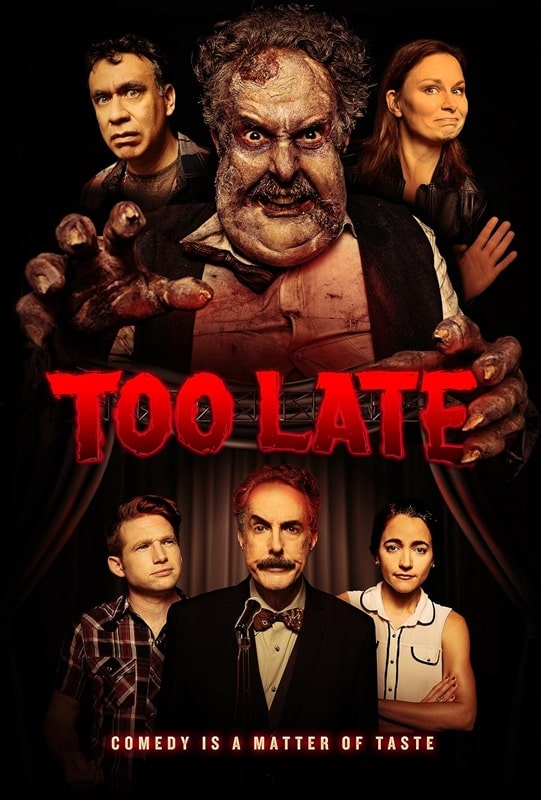

Too Late (Vanishing Angle, June 11, 2015) and Chawz (Lotte Entertainment, July 16, 2009)
Taking a break from gonzo Asian splatter-fests, I found myself settling in for what one might describe as a ‘cozy’ horror-comedy. Personally, I’d describe it as a missed opportunity, but a cursory glance at other reviews reveals I’m in the minority, so what do I know?
Violet (Alyssa Limperis) is the assistant to a famous stand-up comedian, Bob Devore (Ron Lynch), and she helps him find new talent for his late-night live show, Too Late. He doesn’t just need raw talent to entertain his crowds though, as Bob is a supernaturally old, shape-shifting monster that has to eat every four weeks. He’s been in the entertainment business a very long time, and only the most talented acts will sate his hunger. When Violet falls in love with one of his potential meals, she must find a way to terminate her contract and save herself. And that’s about the gist of it. A not-so-subtle allegory for the destructive nature of showbiz.
I’m good with this. It’s a solid concept and the film is well-shot and directed, and for the most part well acted. Fred Armisen and Mary Lynn Rajskub pop up for short cameos, mainly, I suspect, to help get the film funded and to put on the DVD cover, and the rest of the cast is filled out with the usual roster of genre types. They all do their jobs admirably. The horror itself is fairly tame, and other than a shot at the end, relatively bloodless, and I didn’t mind that either.
What I did object to though was the notion that this all takes place against the backdrop of a comedy club, and not a single one of the performers was funny. I get it. Comedy is subjective, but come on, some of this was the dullest observational humour I have ever heard. Not the main focus of the story, but it still irked me enough to get salty as I watched it.
Bottom line, OK.
5/10
Chawz (aka Chaw) (2009)The Korean title Chaw translates to ‘trap’, but this creature feature wears its influences on such a large sleeve, that it was rebranded to Chawz for its US release, capitalizing on that old shark movie.
I’ve been a sucker for giant, mutant boar movies ever since I first watched Russell Malcahy’s Razorback back in the day. Sadly, they are a bit thin on the ground, but this is a good one, so I’m glad I caught up with it.
It’s your usual monster movie fare; giant creature terrorizes a village, eats folk, is a bit of a nuisance etc., plucky group of tropes band together to hunt it down. So far, nothing new. However, this being a Korean film, it has to meet the 2 hour run time, so there is a lot more going on with a broad roster of characters. We have a fish out of water tale with Kim Kang-soo, a freshly transferred cop, a revenge tale with Chun Il-man wanting to avenge his grand-daughter’s savage death, some light comedy via a clutch of goofy cops and hangers-on, a doomed romance, a crazy lady, an incompetent official, etc etc.
It’s a lot to follow, and the film would benefit from a bit of pruning, but on the whole I had fun with it. The monster effects are fine; a combination of puppetry and B-tier CG, and there are plenty of homages littered throughout to prompt a drinking game.
It’s no The Host, but still worth a look.
7/10
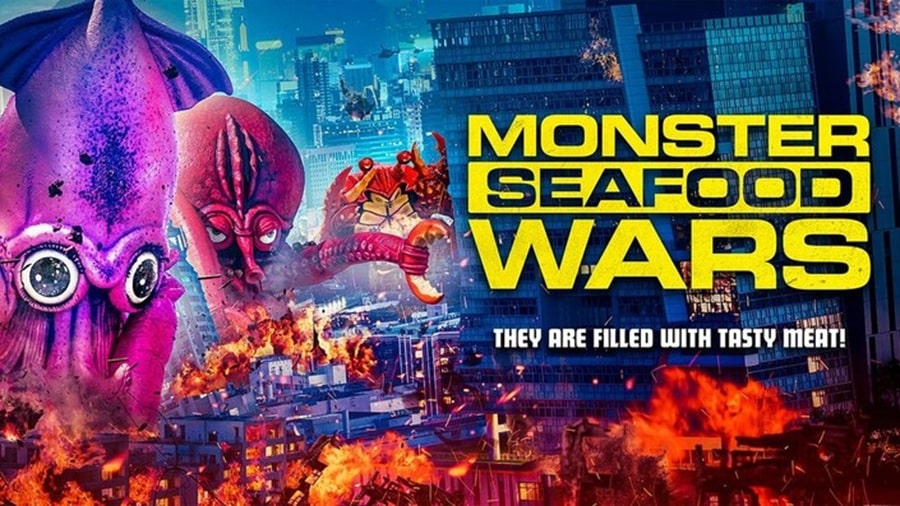 Monster Seafood Wars (Pal Entertainments, June 6, 2020)
Monster Seafood Wars (2020)
Monster Seafood Wars (Pal Entertainments, June 6, 2020)
Monster Seafood Wars (2020)
Never one to turn my nose up at a kaiju slam-fest, I started this one with some trepidation, and was wise to do so. It’s all rather maddening. Stuck inside this ‘comedy’ is a decent monster flick idea; a young slacker scientist creates a serum that can make creatures grow huge in an effort to cure world hunger. His invention is stolen by a nefarious rival, who also steals his shrine offerings (a squid, an octopus and a crab), which are then mutated to ridiculous size and promptly go on a rampage.
The aspect I really enjoyed was the fact that the populace discovers these kaiju are delicious, and so they are happy to let them fight while they control them with vinegar cannons, so that chunks get knocked off and turned into gourmet dishes. That’s what the story should have focused on — it’s a great hook that could allow some excellent moral dilemmas, but instead we have to wade through a tedious love triangle and unnecessary ‘mockumentary’ interviews with the witnesses to the shenanigans.
It also doesn’t help that the monsters themselves are cutesy mascot-style designs with googly eyes and fixed expressions. I wonder how awesome this film could be with realistic creatures and a focus on their deliciousness.
Oh well.
5/10
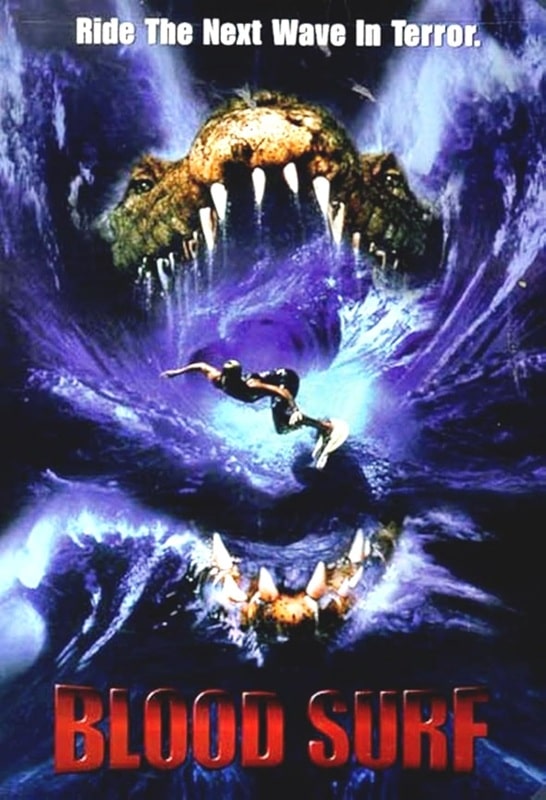

Blood Surf (Trimark Pictures, December 4, 2000) and Body Melt (Beyond Distribution, December 15, 1993)
If you know me by now, I’m always up for a killer crocodile/alligator flick, and when I learned that the late, great John Carl Buechler was responsible for the reptile effects, I got mistakenly excited.
You see, it’s a film about a hugely unlikable group of MTV brats who want to film themselves surfing with chum-crazed sharks, but instead get roped into a croc of shit. The effects are not good, lots of dodgy superimposition, and the filmmakers had no idea how to shoot the big croc puppet. The script is aggressively dumb, the actors deliver their stupid lines with zero interest, and the whole thing is a crushing bore.
What with a Jürgen Prochnow ordered off of Wish, a Matthew Lilliard/Seann William Scott hybrid, and two girls flashing their tits at the beast before one says, “I guess that’s what you call a croc tease,” I was done with it all.
The one single redeeming feature was that one character was called Melba, which allows me to make a ‘Melba was quickly toast’ joke.
Bah.
1/10
Body Melt (1993)Here’s a strange one from down under — a gonzo, sci-fi, body-horror goo-a-thon starring Ian (Harold Bishop from Neighbours) Smith as an evil doctor. Brilliant bit of casting.
The story is about an immoral pharmaceutical company that doles out free pills to the residents of a small community, and then records the various side-effects. Side effects include: exploding body parts (heads, willies, that sort of thing), sentient placentas, randomly placed tentacles, cannibalism, and various amounts of melting.
As you might be able to discern, there are no set rules to the side-effects, and this is the downside to the film. Rather than tell a coherent story, it plays out more as a series of gloopy vignettes, and we really don’t have a main protagonist to follow.
That said, it’s quite ridiculously fun, and there’s plenty of weird stuff going on (and one or two big laughs), so I’m recommending it to all the weirdos out there.
6/10
Previous Murkey Movie surveys from Neil Baker include:
Tubi Dive, Part I
Tubi Dive, Part II
Tubi Dive, Part III
Tubi Dive, Part IV
What Possessed You?
Fan of the Cave Bear
There, Wolves
What a Croc
Prehistrionics
Jumping the Shark
Alien Overlords
Biggus Footus
I Like Big Bugs and I Cannot Lie
The Weird, Weird West
Warrior Women Watch-a-thon
Neil Baker’s last article for us was Part IV of Tubi Dive. Neil spends his days watching dodgy movies, most of them terrible, in the hope that you might be inspired to watch them too. He is often asked why he doesn’t watch ‘proper’ films, and he honestly doesn’t have a good answer. He is an author, illustrator, teacher, and sculptor of turtle exhibits. (AprilMoonBooks.com).
6 Great Audiobooks You Can Enjoy (On audiobooks.com!)
In this LitStack Rec, we take a look at 6 great audiobooks. The voice performances…
The post 6 Great Audiobooks You Can Enjoy (On audiobooks.com!) appeared first on LitStack.
THE INCANDESCENT by Emily Tesh
Leviathan Limited Edition from Lividian
Signed, Numbered, and Slipcased Limited Edition
Includes cover and interior artwork by Vincent Chong
Just Announced and Selling Very Quickly!
Lividian Publications is proud to be publishing a deluxe signed, numbered, and slipcased Limited Edition hardcover of Leviathan by Robert McCammon, the final volume in his acclaimed Matthew Corbett series. This deluxe special edition tips the scales at more than 500 pages and has been lavishly crafted with collectors and readers alike in mind. Vincent Chong provided stunning color artwork for the dust jacket along with a full-color frontispiece and exclusive black and white illustrations for the interior!
Don’t forget that our books are also carried by some of our favorite small presses and retailers:
Bad Moon Books
Buchheim Verlag (Germany)
Camelot Books
Cracked and Spineless Books (Australia)
Jake’s Rare Books
Kathmandu Books
Midworld Press
Overlook Connection
SST Publications (UK)
Subterranean Press
Veryfinebooks
Ziesings
COVER REVEAL: Dragon Along (The Dragons of Nóra #2) by Joseph John Lee

Official Author Website
Preorder Dragon Along over HERE
Dragon Along ARC Sign-up Sheet
Joseph John Lee is an author whom we love at Fantasy Book Critic. He's the author of The Spellbinders & the Gunslingers trilogy. We were so thrilled to be a part of the cover reval for the concluding vlume of the Dragons of Nóra duology.
Dragon Along will be releasing on June 3rd 2025 & here's the cover in all of its glory and do checkout the blurb below

Official Blurb: Sometimes, the promise of a different story doesn’t quite go the way you planned.
After the adventure of a lifetime and hatching a dragon of his own, Camaráin promises his mother that they won’t be forced on the same journey his sister embarked on. That pledge appears to have happened a bit too literally: for as much as Camaráin’s hatchling Brían loves to sit and read with him, they share neither the Bond nor the friendship that Camaráin’s sister had with her dragon.
When his grandparents invite the family to their new home outside the capital city of Mór, Camaráin thinks the extent of his new story is getting rid of the belligerent gnome that has taken up residence in his grandparents’ bathroom. At least, until the gnome forms an instant rapport with Brían that leaves Camaráin flummoxed—and also quite jealous.
If Camaráin is to discover why he cannot form a Bond with his new dragon, he must navigate the strange webs of Mór spun by a secret scholarly society, a band of fae hunters, tourists taking up too much space, and the banned books section at the local library.
Evidently, the days of bonding over books and a cuppa have yet to make their way to the land of Nóra.
The Inheritance: Chapter 5, Part 1

Note: commercial airlines fly at 30,000 feet. Private jets fly higher, with the midsize jets specifically flying at 41,000-45,000 feet.
The plane shuddered as it hit an air pothole. Elias put his hand on the maps spread out in front of him on the table to keep them from sliding off. Across from him, Leo sat very still, his eyes unblinking. His XO didn’t like planes. It wasn’t the flying; it was the lack of control. And if he mentioned it, Leo would just feel more self-conscious and withdraw deeper. Comfort and logic didn’t work for times like these, but distraction did wonders.
Elias turned his attention back to the maps. The sooner he sorted through his thoughts, the faster he could put Leo’s sharp mind to analyzing the Elmwood disaster instead of focusing on being stuck in a metal tube hurtling through the atmosphere 40,000 feet above the ground.
Gate dives had stages. Of all of them, the Assault phase was the main and most important. Humanity entered the gates to destroy the anchor and collapse the breach. Everything else was secondary to this goal, no matter how much some people wanted to twist it. Yes, mining paid the bills, but the focus of the mission was to keep the invasion at bay.
Like many others, Elias felt the anchor the moment he stepped through the gate. It tugged on him, a knot of energy, a distant nexus of power that demanded attention. The stronger you were, the more it pulled on you. Not every gate diver sensed it, and the majority of those who did barely felt it. To them it was a spark, a firefly winking somewhere in the distance. To Elias, it was inescapable, like an evil sun. It called to him, and he hunted it down until he cut through its defenders, forced his way into the anchor chamber, and shattered it.
The trick wasn’t just carving a bloody path to the anchor. The real challenge was to destroy the breach and come out alive. Successful gate dives required preparation. It began with the DDC, who measured the energy emissions of a gate, graded its threat level, and assigned a DeBRA and a guild.
Once Cold Chaos received the assignment, the gate became their problem. An assault team, a mining crew, and an escort was determined, and a gate coordinator was chosen to handle the logistics and keep everything running smoothly.
The assault team deployed to the gate and began the first official phase, the Survey. They progressed carefully into the breach and identified the most likely route to the anchor and promising mining areas. They cleared the mining sites, mapped as much of the immediate environment around them and the gate as was feasible, and came back out.
The next stage was called R&R: Rest and Regroup. Each breach was unique. Open air biomes required larger groups. Cave biomes called for a smaller force with higher individual firepower. Some people didn’t do well in dark enclosed spaces. Others couldn’t swim or had trouble with heights. The assault team reshuffled its roster based on their findings. They reviewed their survey with the escort captain, the mining foreman, and the DeBRA, and then they rested for 24 hours.
After the R&R, the Assault stage finally began. The assault team went back into the breach, swept the mining site one more time, sent a scout back to give the mining team an all-clear, and pressed on toward the anchor. An hour after they entered, the mining crew, the DeBRA, and the escort walked into the breach, made their way to the mining site, and began stripping. A rich site would mean a steady flow of carts filled with resources out of the gate.
If everything went according to plan, the assault team would reach the anchor and destroy it. Without the energy of the anchor, the breach would begin to degrade. The assault team would have to haul ass to the gate, usually sending a scout ahead to warn the mining team to wrap up operations. The breach typically collapsed within 12-36 hours.
That wasn’t what happened in Elmwood.
Radio communications did not work in the breaches, so every assault team carried a “cheesecake,” a beeper stone. Beeper stones occurred in the steppe and mountain biomes and had a core of denser material running through them. When shocked with electricity, they glowed and vibrated. If you broke a piece off and then shocked the core of the main stone, the broken-off piece would also light up and vibrate. Distance didn’t seem to matter. As long as both fragments were in the same breach, shocking the core would activate the other chunk. The first gate diver who discovered this effect compared it to the Cheesecake Factory’s restaurant pager and the name stuck.
The moment the cheesecake was activated, the assault team would know that a fatal event occurred, and they were being recalled. It was the breach equivalent of an SOS. They would turn around and head back for the gate.
The mining crew died less than an hour after entering the gate. As soon as London and the rest made it out, the gate coordinator went into the breach with the core stone, shocked it, and then returned to shock the core stone every half hour for three hours. The assault team was barely two hours into their trek to the anchor. They never came out. It meant only one thing: everyone was dead.
Elias peered at the mining site map. Compasses didn’t work in the breaches, so traditional directions didn’t exist. Instead, the moment you entered, you faced north and the gate behind you was always due south. It was obviously simplified but it worked, and all breach maps followed this principle.
The cave biomes were Elias’ least favorite, and this one was a fucking maze. A tangle of tunnels, passages, and chambers, resulting from eons of erosion as water shaved and carved the stone.
Some people theorized that the breaches were artificial, generated environments, constructed specifically to invade Earth. He never believed in the artificial breach theory. It was bullshit. He’d gone into too many breaches and seen too much. The complexity of the bio systems they encountered was incredible, far too intricate for any artificial construct. No, the breaches were chunks of some other world, maybe worlds, complete with their inhabitants and their own weird rules of survival. And this breach was a perfect example of that. It was old and filled with valuable deposits and extremely dangerous hostiles.
On the surface, Malcolm, the leader of the assault team, had followed the Cold Chaos protocol. The assault team surveyed, they R&R’d, they reentered and swept the mining site for the second time, then started toward the anchor. But the more Elias looked into what actually happened, the wonkier it appeared.
The map in front of him showed Malcolm’s chosen anchor route, which ran almost straight north into the breach. The mining site lay off to the east, roughly a mile from the gate, at the end of a branching tunnel. It was a massive cavern with a stream running north to south. The map showed an entrance in the lower left, through which the mining crew accessed the site, and three tunnels in the north, at the top of the map. The assault team had mapped the tunnels up to half a mile, revealing a tangle of passageways, pits, chambers, and tunnels, half of them carrying running water.
Map of the Mining Site
 Click to enlarge
Click to enlarge
Determining a good mining area was more art than science. The Cold Chaos guidelines for cave biomes dictated that only the larger caverns could be designated as mining sites. The guild lost too many people in tunnel collapses. The mining site had to be safe and defendable, it couldn’t be too far from the gate, and it had to have a good mix of promising minerals identifiable by sight and an abundance of vegetation in case the minerals turned out to be trash. The weirder the site looked, the more promising it would be.
Things would have been so much simpler if they could hire their own assessors, Elias reflected. As it was, they were forced to play the guessing game. That’s why most assault teams identified at least 3 sites.
Malcolm had only picked one.
Elias examined the top edge of the cavern one more time.
Nothing in this world was free. They were never going to go into a breach with fluffy bunnies and rare, priceless resources. The unspoken rule was, the more valuable the find, the harder it would be to extract. Malcolm knew this. He wasn’t sloppy, he wasn’t careless, and yet here they were.
Elias looked at Leo. His XO leaned forward slightly.
“You are Malcolm,” Elias said.
Leo nodded.
Most people assumed that the tank was always the leader. Something about a warrior putting themselves in the path of a threat and soaking up damage while shielding others naturally lent itself to the leader role in people’s imagination. In reality, tanks were almost always too focused on combat to be effective leaders. They were the tip of the spear, and they usually had their hands full.
His own Talent, the Blade Warden, straddled the line between a tank and a damage dealer. He could play either role. On paper, he paid for this versatility with reduced effectiveness. A pure tank Talent, like Sentinel or Protector, of the same power level, could take more damage than Elias. A pure damage dealer, a Pulsecarver or a Stormsurge like Leo, would wreck more havoc. But in the breach, the value of his versatility skyrocketed. He had led teams while tanking – he would do it again in Elmwood – but given a choice, he preferred to go in with a dedicated tank.
Most team leaders were either midfielders or ranged fighters. The ability to survey the terrain was paramount.
Malcolm was an Interceptor, a maneuverable, fast damage dealer. He positioned himself behind the tank, which allowed him to rapidly respond to the changing battlefield. He fought with a spear, could summon plasma javelins, which he hurled at incoming threats, and could teleport about twenty yards once every hour or so.
The man had an uncanny situational awareness. He was slightly precognizant, anticipating the enemy’s actions as well as his team’s. He could predict how and where an opponent would attack and how his people were likely to respond to it. He sensed when someone would need assistance, and he was always where he was needed the most. His only flaw as a team leader was that occasionally he made impulsive decisions. Nine times out of ten, he reacted as expected but once in a while he would roll the dice. To his credit, he was good enough to compensate when his gamble didn’t pay off, but he’d come close to disaster a couple of times.
Elias tapped the map of the mining site. “You find this site. You sweep it. It’s clean. Your next move?”
“I set up aetherium charges in these three tunnels and detonate.”
Exactly. “Why?”
Leo swept his fingers across the three passages veering and branching off, some paths spiraling, others ending abruptly.
“It’s a mess. Everything is connected. The only way to secure the mining site is to prevent access completely. One way in, one way out.”
“Agreed. Malcolm would have known that.”
“Yes.”
The two of them peered at the map. This was basic shit, and yet Malcolm left the tunnels as they were.
“Why?” Elias murmured.
“I don’t know.”
“What’s your best guess?”
Leo considered the map. “Perhaps he was unsure whether he picked the right path to the anchor and thought he might have to double back and take one of the tunnels instead.”
“Yes, but with the firepower in that team and the mining crew’s equipment, he could easily reopen one of the entrances after collapsing it. Why gamble with the miners’ lives?”
Leo shook his head. “I don’t know.”
“Next question: why only one mining site? The protocol suggests at least three. Why this one?”
Leo thought about it. “You think he found something in that cave? Something he had to have?”
“That’s the only thing that would make sense.”
In Malcolm’s place, Elias would have spent another three days on a survey and then doubled back and collapsed those tunnels. Then and only then would it have been safe to bring in the miners. Yes, there would be red tape, and they would have to explain to the DDC why they took their time, but in the end, lives wouldn’t be lost. Instead, Malcolm charged in, pushing the mining crew to the site as soon as the guild regulations allowed.
Leo eyes flashed white. The moment he was left to his own devices, he would take a deep dive into Malcolm’s life. Leo took mysteries as a personal challenge,
Elias leaned back. “Let’s say Malcolm glitched out for some reason. He gets impulsive once in a while, but London doesn’t.”
Leo nodded. “London is careful and risk averse.”
Risk averse. Interesting way to put it. Elias would have to remember that.
The XO frowned. “When the team came out with the survey, London would’ve had to sign off on it. He is the escort captain.”
“Exactly. Did you ask him about it?”
“No. It didn’t occur to me.” A hint of frustration showed on Leo’s face. He was his own worst critic. “I should have. It seems obvious in hindsight.’
The intercom came to life. “We’re beginning our descent into Dallas.”
“Don’t worry too much about it,” Elias said. “London isn’t going anywhere. In a few hours we will ask him about that. And a lot more.”
Leo nodded and buckled his seat belt.
The post The Inheritance: Chapter 5, Part 1 first appeared on ILONA ANDREWS.
Comment on A Beginner’s Guide to Drucraft #36: Essentia Capacity In Practice by Benedict
In reply to Kevin.
There’s no such thing as a Primal sigl that increases your essentia count. There are ones that let you store personal essentia, which lets you simulate a higher essentia capacity, but you don’t get something for nothing – you have to pay that essentia in first (and it’ll de-attune quickly unless you do something to stop it). Also, if your plan is to use multiple sigls at once, you have to actually have enough channelling skill to make effective use of them, which a lot of people don’t.
Comment on A Beginner’s Guide to Drucraft #36: Essentia Capacity In Practice by Kevin
In reply to Benedict.
Ah I should have clarified better!
I meant could you activate a strong enough Primal sigl to increase your essentia count, so you could activate three more. Thus using four activated sigls at once.
But I am guessing from your answer that is not feasible for most Drucrafters unless in cases where you have 2.8 or above Essentia Capacity where that is practical.
Tor Doubles #5: Poul Anderson’s No Truce with Kings and Fritz Leiber’s Ship of Shadows
 Cover for No Truce with Kings by Royo
Cover for No Truce with Kings by RoyoCover for Ship of Shadows by Robin Wood
Both Poul Anderson’s No Truce for Kings and Fritz Leiber’s Ship of Shadows originally appeared in issues of The Magazine of Fantasy and Science Fiction, Not only did their initial publication occur in the same periodical, but both of those original issues sported covers painted by Ed Emshwiller.
No Truce for Kings was originally published in F&SF in June, 1963. It won the Hugo Award and received a Prometheus Hall of Fame Award in 2010. No Truce for Kings In is the first of three Anderson stories to be published in the Tor Doubles series.
Colonel James Mackenzie is the commander of Fort Nakamura in a post-apocalyptic California who receives a message that Judge Brodsky has been deposed and replaced by Judge Fallon. This message is the indication to Mackenzie that a civil war has broken out. Although Mackenzie and his troops are loyal to the old regime, the letter makes it clear that Mackenzie’s son-in-law, Thomas Danielis, is aligned with the rebels, as well as serving as a hostage for the troops who are coming to relieve Mackenzie of his command.
The story alternates between Mackenzie’s and Danielis’ actions in the subsequent war, and although Anderson includes many indicators of what the old regime looked like, with a series of local feudal lords called bossmen, and the attempts to destroy that society by the forces of Fallon and his allies, the use of time jumps throughout the story give it a somewhat disjointed feel. However, the use of a Mackenzie and Danielis, as relatives, along with the occasional appearance and frequent mention of Laura, Mackenzie’s daughter and Danielis’ wife, as well as her pregnancy and the birth of her child, combine to give the discussions of tactics and strategies a more personal flavor throughout the story.
While No Truce for Kings starts out as a pretty generic post-apocalyptic story, Anderson adds in an alien element that sets it apart. His aliens, who mostly appear in conversation with themselves as observers of the actions of the humans seem as if they are a response to the psychohistorians of Isaac Asimov’s Foundation series, which was originally published twelve years before No Truce for Kings. These aliens make use of psychodynamicism to guide the events of the humans as they come out of the fall of civilizations. Furthermore, while Asimov created the religion of scientism to help guide the galaxy, Anderson’s aliens have introduced Espers, people who ostensibly have psychic abilities.
The interludes have only a minor direct impact on the action of the story, but they allow Anderson to provide the information the reader needs so the main characters can continue interacting with their world without providing a data dump and allows the reader to have additional background knowledge they don’t have. When Mackenzie comes into contact with a group of Espers, who are theoretically neutral in the war between Fallon and Brodsky, the information Anderson has provided in the discussion of his aliens provides more depth to the Espers’ actions that may seem odd to Mackenzie but can be explained away, except the reader has an understanding where he has gone wrong.
Anderson doesn’t just place Danielis and his father in law on opposite sides of the war, he provides them with a reason for being on those sides. Mackenzie grew up in the system of bossmen and thrived because of it. To him it was the natural order of things. Danielis was an orphan who had to work his way up through the system, eventually succeeding in a military career. He was helped along the way by the Espers, and although they were officially neutral, there is no point in the story that it doesn’t seem like common knowledge that they are supportive of Fallon’s rebellion.
Eventually, of course, the existence of the aliens becomes known and changes the course of the war. The forces of Fallon and Brodsky, all of whom are aware that there was once a more unified country that had collapsed and all of whom have hopes to reestablish in their own ways, suddenly become aware that there is more out there, and can offer them a higher level of technology than humans had previously had access to. This is an area that Anderson had previously explored in works like The High Crusade, published three years before No Truce for Kings. Although Anderson addresses the dichotomy of science, it is done in an almost cursory manner, providing the story with something of an anticlimax from that point of view.
At the same time, his decision to follow Danielis and Mackenzie throughout, focusing on their experiences and the stresses caused by the knowledge that they were on opposite sides of the civil war, imbues the story with a human connection that ultimately does come to a satisfying conclusion, even if the situation does not allow for a happy outcome for all who are involved.
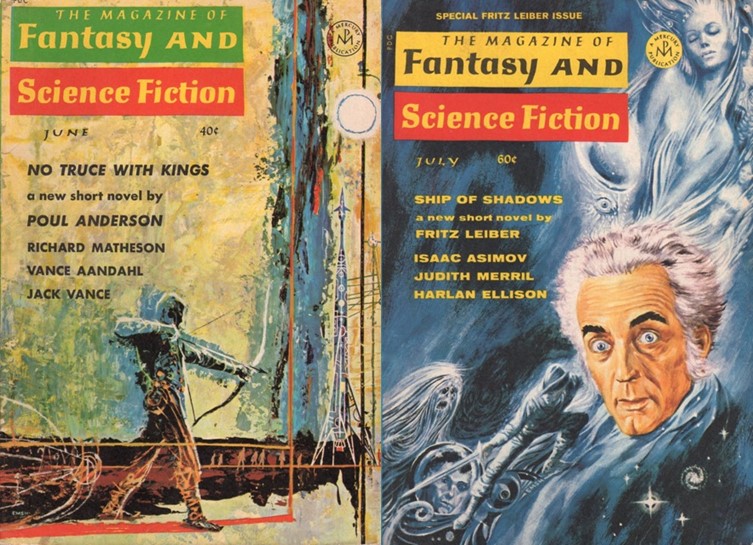 Fantasy and Science Fiction 6/63 cover by Ed Emshwiller
Fantasy and Science Fiction 6/63 cover by Ed EmshwillerFantasy and Science Fiction 7/69 cover by Ed Emshwiller
Ship of Shadows was originally published in F&SF in July, 1969, which was an issue dedicated to Fritz Leiber and included a portrait of him by Ed Emshwiller on the cover. The issue included essays on Leiber by Judith Merril and Al Lewis as well as a reprint of Leiber’s recent poem “iix. ‘Out the frost-rimmed windows peer,…’” and this original novella. Ship of Shadows was nominated for the Hugo Award and the Nebula Award, winning the former. Ship of Shadows is the first of four Leiber stories to be published in the Tor Doubles series, including two that would be published in the final official release of the series.
There is a saying that science fiction (and fantasy) stories have to teach the reader how to read the individual story. The readers must be taught which words should be taken literally and which can be understood metaphorically. Nothing about the story’s setting can be assumed and the reader should allow the author to explain where the story is taking place. Leiber is more than happy to keep the reader in the dark about the actual location in which Ship of Shadows takes place, only revealing the details slowly.
The reader’s entry into this world is Spar, an older man who works as a bartender at the Bat Rack, a dive which serves moonmist, a low grade alcohol. Spar is accompanied by Kim, a talking cat who seems to be his closest friend, although Spar also has a connection with his boss, Keeper, and several of the bar’s patrons, ranging from Doc to Crown to the various women who frequent the bar. Those relationships range from awkwardly cordial to almost adversarial.
Spar has bad teeth and can barely see. He prefers to stay in his menial job at the Bat Rack rather than explore the world around him, taking comfort in the known space, even though it is relatively clear to the reader that even those who seem to have affection for Spar do not respect him or see him as an equal. Even Kim appears to view Spar more as a means to an end.
The world he inhabits appears to be one in which witches and zombies move with impunity, a four day week is in place which includes days for work, idleness, play, and sleep. The world, referred to as Windrush, may also be a ship of some sort, although the characters are not fully aware of its nature. How much of Spar’s knowledge of his world is accurate, how much is legend, and how much is authorial misdirection only becomes partially clear as the novella continues.
Just as Spar seems to have a limited understanding of the world in which he lives, Leiber isn’t in any hurry to provide the reader with any details. It isn’t until he is sent on an errand by Keeper that the world begins to come into an sort of focus, perhaps reflective of the fact that during the errand Spar plans to make a stop to see Doc and have him provide Spar new teeth and new eyes. In his travels, Spar discovers a that Windrush has a variety of different neighborhoods which don’t quite mesh with the world he has pictured living and working in the Bat Rack.
His travels take him to the Bridge, a world of “irregularly pulsing rainbow surfaces, the closest of which sometimes seemed ranks of files of tiny lights going on and off—red, green, all colors. Aloft of everything was an endless velvet –black expanse very faintly blotched by churning, milky glintings.” This revelation, which will be recognized by readers, is strengthened by the fact that it is described through Spar’s imperfect eyesight, which further reinforces the idea that, through no fault of his own, Spar’s impressions of his world of unreliable.
Because of the amount of information Leiber keeps hidden from the reader (and his characters), Ship of Shadows is the sort of work that benefits from re-reading. The first pass lives the reader at a loss for much of the story, but once the explanations come late in the tale, they can illuminate the earlier action when read with the knowledge of what Leiber will eventually reveal.
The cover for No Truce for Kings was painted by Royo. The cover for Ship of Shadows was painted by Robin Wood.
 Steven H Silver is a twenty-one-time Hugo Award nominee and was the publisher of the Hugo-nominated fanzine Argentus as well as the editor and publisher of ISFiC Press for eight years. He has also edited books for DAW, NESFA Press, and ZNB. His most recent anthology is Alternate Peace and his novel After Hastings was published in 2020. Steven has chaired the first Midwest Construction, Windycon three times, and the SFWA Nebula Conference numerous times. He was programming chair for Chicon 2000 and Vice Chair of Chicon 7.
Steven H Silver is a twenty-one-time Hugo Award nominee and was the publisher of the Hugo-nominated fanzine Argentus as well as the editor and publisher of ISFiC Press for eight years. He has also edited books for DAW, NESFA Press, and ZNB. His most recent anthology is Alternate Peace and his novel After Hastings was published in 2020. Steven has chaired the first Midwest Construction, Windycon three times, and the SFWA Nebula Conference numerous times. He was programming chair for Chicon 2000 and Vice Chair of Chicon 7.
Bewitching the Orc Chief - Book Review by Voodoo Bride
 Bewitching the Orc Chief (Silvermist Mates #1)by Chloe Graves
Bewitching the Orc Chief (Silvermist Mates #1)by Chloe GravesWhat is it about:The most potent magic is sealed with a bite.
MirandaAll I wanted was one night of normal after a year of... avoiding my former coven. Instead, I got an orc chief who took one look at me and growled "mine." One scorching night later, I wake up in his village—which is definitely not what I had in mind for the morning-after.
Now I'm surrounded by suspicious orcs, trying to keep my magic under wraps, and fighting an inconvenient attraction to my very large, very possessive "host." But hey, at least my familiar likes him—the traitor.
OsenThe clan elders demand I take a mate to secure my position as chief. I didn't expect fate to hand me a witch who makes my blood burn and my instincts roar to mark her again. And again.
Our shaman spits venom about dark magic, while my uncle circles like a vulture. But when my brother lies bleeding out and her forbidden power yanks him back from the brink, I know I'll burn down tradition to keep her.
Then her coven tracks her to my mountains, and I discover exactly what kind of darkness my mate has been running from. They want to drain her magic and steal her power—but they'll need to go through me first.
My mate. My witch. And I'll destroy anyone who tries to take her from me.
What did Voodoo Bride think of it:I really enjoyed Vexing the Grumpy Orc, so I decided to get the other books in this series as well. So after starting this series with book 3, now it was time for book 1.
If I had started with this book it would have been immediately clear this is Urban Fantasy Romance. The Orc village feels really Other World Fantasy, but outside of their village things are modern. This book made that immediately clear, where book 3 took some time to get away from the village.
I liked the overall story and romance well enough, but this romance had one major turn-off: How much Osen kept mentioning his brother during one of the steamy scenes. I mean: if anyone would do that with me, I'd be out of there, Mate or not. I usually am not one to skim steamy scenes, but here I totally did.
That aside: I liked the book well enough, but I didn't connect with Osen or Miranda as much as I did with Galan in Vexing the Grumpy Orc. I still liked it enough that I'll read book 2 soon.
Why should you read it:It's an enjoyable Orc Romance
Comment on A Beginner’s Guide to Drucraft #36: Essentia Capacity In Practice by Benedict
In reply to Kevin.
You can use as many sigls as you want – you can use ten if you like – but unless you’ve got a superhuman essentia capacity, you’re only going to have enough essentia to actually activate 2.5 to 3 of them at once, same as anyone else.
Comment on A Beginner’s Guide to Drucraft #36: Essentia Capacity In Practice by Kevin
Very informative as always, with this info it makes me wonder if Tobias and Helen are using Essentia Capacity prejudice as an excuse for why they are not the heirs.
On the topic of Essentia Capacity, and since I love loophole abuses is it possible to use four sigls at once with one of them being a Primal sigl increasing essentia to “trick the body” as it were into thinking it can use three sigls?
Audiobook Review: The Maid’s Secret by Nita Prose
I received a review copy from the publisher. This does not affect the contents of my review and all opinions are my own.
 The Maid’s Secret by Nita Prose
The Maid’s Secret by Nita Prose
Mogsy’s Rating (Overall): 4 of 5 stars
Genre: Mystery
Series: Book 3 of Molly the Maid
Publisher: Random House Audio (April 8, 2025)
Length: 11 hrs and 3 mins
Author Information: Website
I’ve been following the Molly the Maid series since The Maid which first introduced its unforgettable protagonist to readers, so it is with a mix of warmth and bittersweetness that I approached The Maid’s Secret. Although I can’t say with a hundred percent certainty, judging by the emotionally satisfying conclusion and the way everything seemed to be neatly tied up, I suspect this may very well be Molly Gray’s last case.
This time around, life is looking up for Molly. In The Mistletoe Mystery novella published shortly before this novel, her boyfriend Juan Manuel proposed so now the couple is joyfully preparing for their upcoming wedding. But holding dual roles as Head Maid and Special Events Manager at the Regency Grand also means Molly is kept quite busy, especially when an upcoming episode of the popular antique appraisal series Hidden Treasures is set to be filmed at the hotel. When the show’s charismatic hosts, Brown and Beagle, invite the staff to take part in the event, Molly decides to throw together a few of her late grandmother’s keepsakes in a simple shoebox to bring along.
Much to everyone’s surprise, a sparkly bejeweled egg among Gran’s old possessions turns out to be a priceless Fabergé prototype. Announced in front of a live audience, the news catapults Molly into the spotlight and turns her into an overnight celebrity. With the egg’s value appraised at millions of dollars, she also suddenly finds herself fielding questions about whether she will sell it and what she might do with the fortune if she does. After all, with that much money, she and Juan Manuel would be able to have the wedding of their dreams, not to mention financial stability for the rest of their lives. But just as things seem too good to be true, the egg is stolen in a brazen heist, and Molly finds herself embroiled in another high-profile mystery.
As it turns out, the only clues as to who stole the priceless heirloom may lie in a newly discovered diary written by Gran, whose secret past as a wealthy young heiress ends up being the key to everything. The end result is a novel created by two separate, alternating narratives: one that follows Molly’s present-day investigation, and another that reveals Gran’s coming-of-age tale as young Flora Gray.
This dual timeline structure adds a deeper layer of emotional resonance to The Maid’s Secret by exploring the protagonist’s family legacy, thus making it far more complex than its predecessors beyond just a simple whodunit. While the cozy charm of the Regency Grand still grounds this story, Gran now shares the spotlight with Molly through her diary entries, which are addressed to her beloved granddaughter. These chapters add a historical touch and no small amount of nostalgia as they unfold with poignant drama, chronicling Flora’s struggles against her cold, controlling parents. Determined to secure their daughter’s future with a marriage into another wealthy family, they are blindsided when Flora chooses to follow her heart instead, engaging in a forbidden romance with a servant’s son.
Inevitably though, the focus is shifted away from Molly and her friends and colleagues in the present, which may disappoint readers who were expecting more from the tightly knit Regency Grand group. Young Gran’s chapters feel like a world away in comparison, and if you came to this book for more Molly, this unexpected turn of events might feel a bit like a bait-and-switch. Nevertheless, Flora’s past provides essential context for the furor surrounding the central mystery regarding the stolen Fabergé, and personally I found her backstory fascinating. As someone who has always loved the sweet, heartwarming nature of the relationship between Molly and Gran, I felt that the latter’s diary entries managed to bring the series full circle with beautiful purpose.
To sum it all up, if The Maid’s Secret is indeed the series’ finale, in my opinion you couldn’t ask for a more fitting conclusion. Molly remains a singular and beloved character who has grown so much over the last three novels, and I had fun watching every moment of her journey. The stories in these books might not be the most thrilling or unpredictable, but they are warm and comfortable and uplifting, like a favorite sweater or a hot cup of tea on a chilly day. A well-deserved round of applause also goes to Lauren Ambrose for her impeccable work as narrator on these audiobooks. Listening to this whole series has been an absolute joy.
![]()
![]()
More on The BiblioSanctum:
Review of The Maid (Book 1)
Review of The Mystery Guest (Book 2)
Review of The Mistletoe Mystery (Book 2.5)
We Could Be Magic Tour, Preorder Goodies, and Upcoming Giveaways!
Happy Spring! It’s nearly time for the release of WE COULD BE MAGIC, my new swoony YA graphic novel, and I have goodies to share!
There is a preorder campaign going on now for readers in the US and Canada. Preorder your copy and upload your receipt to receive these special items below:
• An adorable scrunchie set inspired by the book
• An exclusive digital sneak peek of THE HOUSE SAPHIR (my next fairy tale retelling, coming out this fall!)

A swoon-worthy young adult graphic novel about a girl’s summer job at a theme park from #1 New York Times bestselling author Marissa Meyer.
When Tabitha Laurie was growing up, a visit to Sommerland saved her belief in true love, even as her parents’ marriage was falling apart. Now she’s landed her dream job at the theme park’s prestigious summer program, where she can make magical memories for other kids, guests, and superfans just like her. All she has to do is audition for one of the coveted princess roles, and soon her dreams will come true.
There’s just one problem. The heroes and heroines at Sommerland are all, well… thin. And no matter how much Tabi lives for the magic, she simply doesn’t fit the park’s idea of a princess.
Given a not-so-regal position at a nacho food stand instead, Tabi is going to need the support of new friends, a new crush, and a whole lot of magic if she’s going to devise her own happily ever after. . . without getting herself fired in the process.
With art by Joelle Murray, the wonder of Sommerland comes to life with charming characters and whimsical backdrops. We Could Be Magic is a perfect read for anyone looking to get swept away by a sparkly summer romance.
How to get your swag:
- Preorder your copy via my Bookshop.org store (or wherever you normally purchase your books).
- Submit your receipt here. US/Canada only. See link for full details.
I’m going on tour and hope to see you!
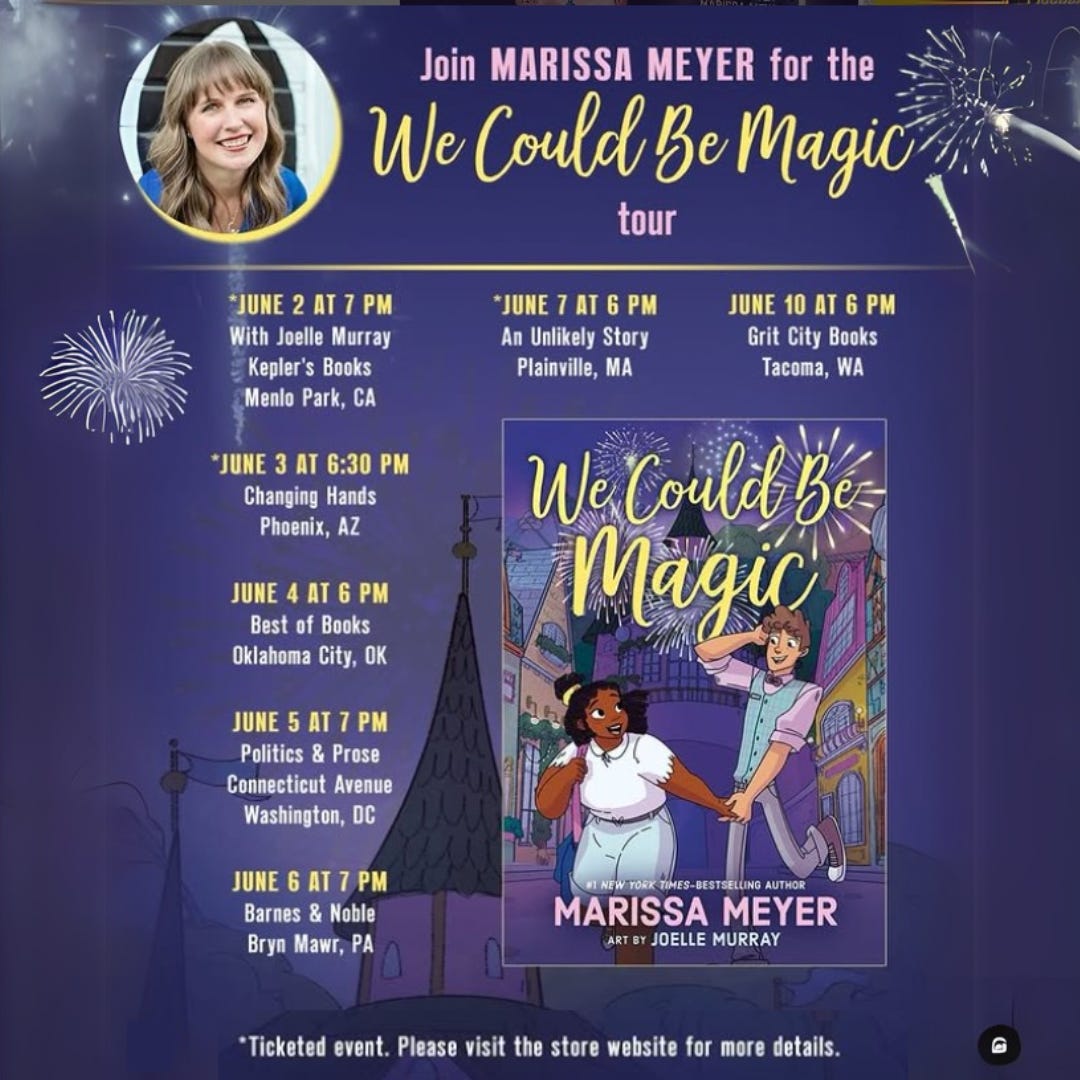
See the special tour linktree for individual event details and ticketing.
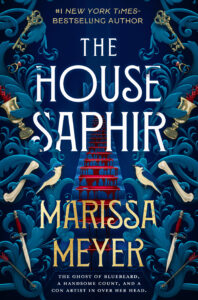 The House Saphir
The House Saphir
I know many of you are anxiously awaiting THE HOUSE SAPHIR. Not only is there an exclusive sneak peek coming for those who preorder WE COULD BE MAGIC, but other giveaways are coming, including a romance inspired one over on Instagram, so make sure you follow me to get the latest.
THE HOUSE SAPHIR comes out November 4, but you can add it to Goodreads now and preorder your copy from my store at Bookshop.org (or wherever you get your books). Don’t forget to keep those receipts *hint, hint*.
Until next time, happy reading and I hope to see you soon on the WE COULD BE MAGIC tour!
With love,
Marissa
The post We Could Be Magic Tour, Preorder Goodies, and Upcoming Giveaways! first appeared on Marissa Meyer.
Goth Chick News: Exploring GalaxyCon’s Newest Addition – Nightmare Weekend
 Nightmare Weekend Chicago 2025
Nightmare Weekend Chicago 2025
One of the most entertaining aspects of working for Black Gate is hitting the road with Photog Chris Z to cover horror-themed events in the Midwest. Though many people think about Halloween during the fall months, there is an enormous subculture of vendors, artists, and fans for whom the spooky season never ends. This year, Chicago was not only the site of an entirely new show just for this audience but also the first city to host it—and we had a front-row seat on opening night.
GalaxyCon, LLC, founded in 2006 by Mike Broder and based in Fort Lauderdale, Florida, is one of the leading organizers of pop culture conventions in the United States. Initially focused on comic books, anime, and broader fan engagement, GalaxyCon has successfully expanded its portfolio to include horror-themed entertainment with its Nightmare Weekend series.
 The crowd at Nightmare Weekend Chicago 2025
The crowd at Nightmare Weekend Chicago 2025
The expansion into horror began in response to the genre’s increasing popularity, particularly its blend of nostalgia, cult fandom, and crossover appeal to mainstream audiences. With Nightmare Weekend, GalaxyCon has carved out a distinct identity in the horror convention scene, blending celebrity meet-and-greets, specialized vendors, themed parties, and curated entertainment.
The Nightmare Weekend events (of which there are four more in other cities this year) reflect Broder’s business philosophy of engaging fans across diverse interests. “Horror is not just a genre; it’s a lifestyle for many fans,” Broder explained in a recent interview. “Nightmare Weekend is our way of celebrating the culture and giving horror enthusiasts a place to connect and indulge their passion.”
 Best. Cosplay. Ever.
Best. Cosplay. Ever.
We were thrilled to get an invite to cover the inaugural event in Chicago last weekend. To start, there was an impressive lineup of celebrities, including William Shatner, Jeremy Renner, and Barry Bostwick just to name a few. Unfortunately, many of the top names only appeared on Saturday and Sunday so we missed them. Chris Z did get to meet his favorite cosplayer, Ashlynne Dae and we both had a chance to catch up with our favorite Munster, Butch Patrick, who is starting to feel like a member of the family.
Though GalaxyCon hasn’t released official stats for Nightmare Weekend Chicago, we counted roughly 100 artists in the “Artists Alley” area and over 150 vendors, who together occupied one of the largest halls in the Rosemont Convention Center. We inevitably saw a few people and products we had seen at other shows. However, we were thrilled at all the uniqueness we found. Here’s few in no particular order…
 Soheyla Seiff and her incredible wreaths
Soheyla Seiff and her incredible wreaths
Seiffs Wreaths: Based in South Elgin, Illinois, Soheyla Seiff has been crafting handmade, custom wreaths since 2024. The company specializes in creating unique deco mesh wreaths that cater to a variety of themes, including holidays, special occasions, pop culture, and horror fandoms. Each wreath is meticulously designed to reflect its theme, offering customers a personalized touch to their decor. Notably, Seiff’s Wreaths has gained recognition for its horror-themed wreaths, featuring designs inspired by classic horror films and characters, making them a favorite among genre enthusiasts. Customers can explore and purchase these handcrafted creations through Seiff’s official website or their Etsy shop, where each piece is made with attention to detail and a passion for thematic artistry.
 Wynnwood Farms Teas, Elixirs & Bitters
Wynnwood Farms Teas, Elixirs & Bitters
Wynnwood Farms Teas, Elixirs & Bitters: This boutique tea and apothecary brand, based in Houston, Texas, and owned by Alexandria and Debbie Wynn, offers a unique fusion of storytelling and sensory indulgence through their “Dead to Me Collective” collection. This curated selection features horror and storybook-themed teas, elixirs, and bitters, each crafted to transport consumers into a world of imagination and flavor.
The “Midnight Horror” tea line pays homage to classic horror narratives, with blends like “Dr. Frankenstein,” “Final Girl,” and “The Raven,” inviting tea enthusiasts to experience tales of terror and intrigue with every sip. Complementing these are their handcrafted elixirs and bitters from “The Spellbound Alchemist” series, meticulously produced in small batches by a mother-daughter duo. These concoctions, such as “The Lovers” cocktail bitters — a blend of chocolate, cherry bark, and vanilla — are designed to elevate both wellness routines and mixology experiences.
 Crystallo Card Game
Crystallo Card Game
Crystallo Card Game: It wouldn’t be a convention without one of us picking up a new game. Though this isn’t “horror” per se, it is still a very cool concept. Plus, the shiny things attracted my attention. Crystallo, designed by Liberty Kifer, is a solo card game where players rescue magical creatures trapped by the Black Dragon’s crystal magic. Combining set collection and tile placement, the game challenges players to form crystal patterns and ultimately trap the dragon. With stunning artwork, tactile acrylic gems, and a 30-minute playtime, Crystallo offers an engaging and replayable experience for solo gamers. Expansions like “Untold Fortune” and “Den of Dragons” add depth and complexity to this enchanting adventure.
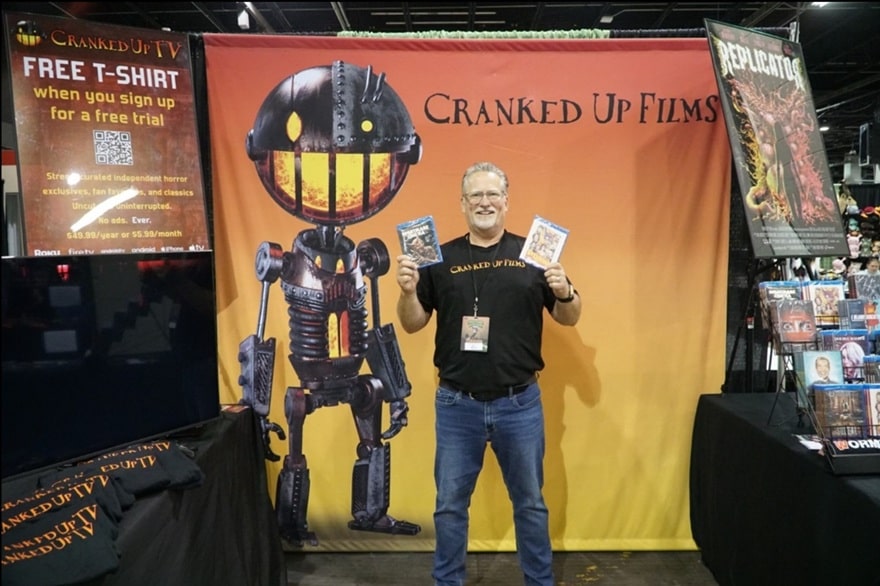 Scott Donley and Cranked Up Films/TV
Scott Donley and Cranked Up Films/TV
Good Deed Entertainment: Scott Donley is the founder and CEO of Good Deed Entertainment (GDE), an independent film studio established in 2012 and headquartered in Ashland, Ohio. Under Donley’s leadership, GDE has built a reputation for producing and distributing character-driven content across various platforms, including film, television, and digital media. The company is perhaps best known for releasing the Academy Award-nominated animated feature Loving Vincent, which tells the story of painter Vincent van Gogh in his signature style. In addition to Loving Vincent, GDE has distributed titles such as Karmalink, Carmen, and Some Freaks, along with the Independent Spirit Award-nominated To Dust and the Annie Award-nominated Charlotte.
Recognizing the growing interest in genre films, Donley launched Cranked Up Films, a division of GDE that focuses on high-concept horror, grounded sci-fi, and speculative fiction. This initiative has led to the production and distribution of films like Nightmare Cinema, a horror anthology featuring segments directed by notable filmmakers such as Mick Garris (Sleepwalkers, Critters 2) and Joe Dante (Gremlins, The Howling). Donley was at Nightmare Weekend promoting his newest venture, Cranked Up TV, the premier destination for ad-free, independent horror, so we now know where our next binge-watch will come from.
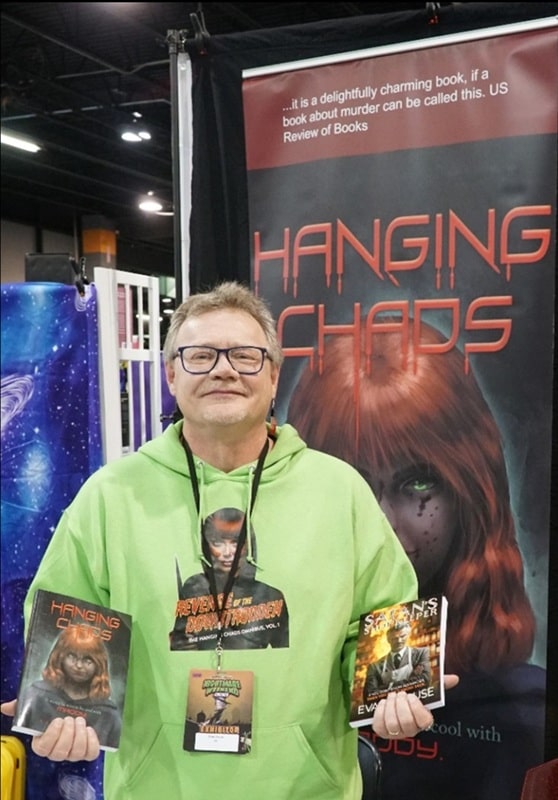 Author Evan Clouse of Hanging Chad Books
Author Evan Clouse of Hanging Chad Books
Hanging Chads Books: Evan Clouse, a former social worker turned author, has made a notable entry into the horror genre with his Hanging Chads series. Launched during what he humorously refers to as his “2/3-life crisis,” Clouse’s writing delves into dark, satirical narratives that blend horror, political commentary, and dark humor. The series follows Maddy Sommers, a vigilante serial killer targeting abusers and oppressors, offering readers a mix of gruesome justice and emotional depth. Clouse’s work has been recognized for its unique approach to horror, combining elements of mystery, love, and social critique.
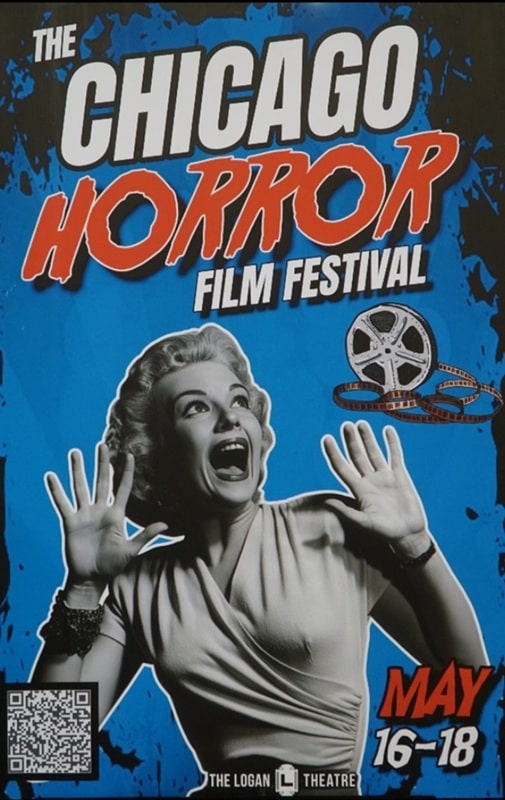 The Chicago Horror Film Festival 2025
The Chicago Horror Film Festival 2025
Last, we had to tell you about two other Midwest events coming soon. The Chicago Horror Film Festival 2025 celebrates its 26th year at the Logan Theater May 16-18. Touted as one of the top 10 horror festivals worldwide, CHFF showcases a curated selection of independent horror films from around the globe, including local and international shorts and features. Tickets start at just $10, with full weekend passes available for $68.99.
The Milwaukee Horror Con returns for its “Fall Frightmare” edition from September 5–7, 2025, at the Four Points by Sheraton Milwaukee Airport Convention Center. As Wisconsin’s only dedicated horror convention, this three-day event promises an immersive experience with horror legends, indie film screenings, themed vendors, cosplay contests, and late-night thrills.
As for GalaxyCon, they are aggressively broadening the reach of Nightmare Weekend to new cities in 2025, including:
- Nightmare Weekend Cleveland: August 29–31, 2025, at the Huntington Convention Center in Cleveland, Ohio.
- Nightmare Weekend Des Moines: September 12–14, 2025, at the Iowa Events Center in Des Moines, Iowa.
- Nightmare Weekend Richmond: October 17–19, 2025, at the Greater Richmond Convention Center in Richmond, Virginia.
- Nightmare Weekend Savannah: November 14–16, 2025, at the Savannah Convention Center in Savannah, Georgia.
A huge thanks to Justin Burkhardt and the Nightmare Weekend promotions team for including us in this first-ever event. We can’t wait for next year.
OUT NOW – The Counterfactual War
The Protectorate – an interdimensional empire that has conquered five timelines so far – has set its sights on ours. Led by a man willing to risk everything for power and conquest, armed with technology a hundred years ahead of ours – technology promising salvation to its allies and doom to its enemies – and drawing on a far deeper military history, the Protectorate Expeditionary Force has arrived to invade and incorporate our world into the greatest empire the multiverse has ever known, or die trying.
The United States has won a desperate battle against the crosstime invaders, but large swathes of the country remain under enemy occupation, the struggle to understand invader technology has barely begun and a new invasion force has appeared in the Middle East. As the country staggers and threatens to collapse, the military prepares for a major offensive that could make or break the war, while – deep in the heart of Texas – the invaders prepare a plan of their own …
One battle has been won. The war is far from over.
Download a FREE SAMPLE, then purchase from Amazon US, UK, CAN, AUS, Books2Read.

Spotlight on “The River is Waiting” by Wally Lamb
The River Is Waiting is the propulsive story of a young father who, after an…
The post Spotlight on “The River is Waiting” by Wally Lamb appeared first on LitStack.
On McPig's Radar - Never the Roses
Did I already post about this book before?
And did I already read it because I know the author and she gave me an early digital copy?
Yes! to both these questions.But this book is so good!
Believe me: you want it! It's utterly amazing and beautiful in and out!
Go preorder: I totally did.
 Never the Rosesby Jennifer K. Lambert
Never the Rosesby Jennifer K. LambertUNSTOPPABLE WAR. UNSPEAKABLE SINS. IMPOSSIBLE LOVE.
Genevieve Gornichec’s The Witch’s Heart meets Madeline Miller’s Circe in this epic and deeply emotional romantic fantasy debut by Jennifer K. Lambert. The hardcover edition features beautiful stenciled edges.
The Dread Sorceress Oneira has retired. She’s exhausted from fighting the endless wars of kings and queens, and has long accepted that her death is near. Alone at last but for a few uninvited companions―a near-mythical wolf, a goddess’s avatar, and a feline that embodies magic itself―Oneira realizes that she’s bored. On a whim, or perhaps at the behest of fate, she makes an unlikely trip to the most extensive library in existence: the home of her most powerful rival, the sorcerer Stearanos.
By recklessly stealing a book from him, Oneira inadvertently initiates a forbidden correspondence. Taunting notes and clever retorts reveal a connection neither has found―nor could ever find―in any other.
But Oneira soon learns that Stearanos, bound to a vile king, is tasked with waging war on the queen she once served. A relationship with him is far too dangerous to pursue despite their mutual desire―and yet, Oneira can’t seem to stay away.
A bond with Stearanos could alight the long-extinct flame of life within her… or it could destroy her entirely.
Expected publication July 8, 2025
Back to Life, Back to Reality and Book Recommendation
The vacation was amazing. The air was 80F. The ocean was 80F. The pools were great. The room was spectacular. The food was delicious. The drinks were to die for.



We went on a date to this restaurant that was technically part of the resort but set outside of the grounds, by a busy street. We sat on a terrace, under a canvas, watched the foot traffic and listened to a remarkably good live singer. At some point I had a moment of wondering if this was actually happening. It’s been so long since we had a vacation. Last year, we had a weekend in Daytona. That was it. I needed this in the worst way.
We swam so much. I miss it already.
We are back home, and the dishwasher drainage line is clogged. We’ve taken the dishwasher apart, checked the fan, and have done the boiling water trick, so it looks like we have to get a plumber involved. Reality, coming like a freight train.
Professional NewsThis Kingdom is a hot potato. We have now sold the rights to 5 foreign countries, most of which we cannot contractually disclose yet, but we are free to say that we will be working with Tor UK. We are very excited.
We have seen the cover sketches. They sent 3 sketches and all three were great. We picked a favorite and can’t wait to see it in color and detail. I don’t want to jinx it, so I won’t say more.
Book RecommendationI usually don’t read while we work. It’s very hard to shift gears from concentrating on the narrative to enjoying it. While on vacation, though, I downloaded a series through Kindle Unlimited and I glomed it. I’ve read 4.5 books at this point. Big thanks to Matt, Alisha, Sauron, and Christy for recommending the Azarinth Healer series.
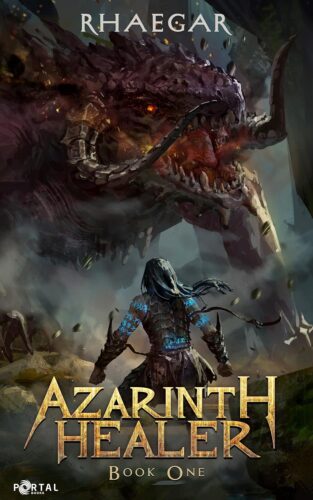
Ilea likes punching things. And eating.
Unfortunately, there aren’t too many career options for hungry brawlers. Instead, the plan is to quit her crappy fast-food job, go to college, and become a fully functioning member of society. Essentially – a fate worse than death.
So maybe it’s lucky that she wakes up one day in a strange world where a bunch of fantasy monsters are trying to kill her…?
On the bright side, ‘killing those monsters right back’ is now a viable career path! For she soon discovers her new home runs on a set of game-like rules that will allow her to punch things harder than in her wildest dreams. Well, maybe not her wildest dreams, but it’s close.
With no quest to follow, no guide to show her the way, and no real desire to be a Hero – Ilea embarks on a journey to discover a world full of magic. Magic she can use to fight even bigger monsters.
She’s struggling to survive, has no idea what will happen next, and is loving every minute of it. Except, and sometimes also, when she’s poisoned and/or has set herself on fire. It’s complicated.
Read the story that took Royal Road by storm with over 60 million views and counting.
It’s a classic LitRPG, the stats, the battles, the violence. A prefect beach read for me. I really enjoyed the action. The protagonist is endearing and is authentically a 20 year old. The world is imaginative and exciting. The Silver Rose dungeon was chef’s kiss. I’m a horrible harpy who hates everything, and I couldn’t stop reading it. If you like LitRPG, this is a good one.
For the romance readers: there is none. There is some casual sex with the door closed.
There is an audiobook and it is good. I listened to about half of the first one on the plane.
Fair warning for people fresh to the genre: this series concentrates a lot on the battles. You get very detailed blow by blow fights. I like battles and there were times my eyes started glazing over. Like if you think our fight scenes are too long, these are much more detailed.
Here is the link to Amazon: Azarinth Healer. There is always another drake.
The post Back to Life, Back to Reality and Book Recommendation first appeared on ILONA ANDREWS.
Life Lessons from David Cronenberg
Let me begin with two assertions, each of which is, in the immortal words of Vincent Vega, “a bold statement.” First: David Cronenberg is one of our greatest directors, and there is nothing he has done that isn’t worth seeing. Second: I am the dumbest, most suicidally foolhardy person you will ever meet. The first statement is arguable, ultimately a matter of opinion, but the second is not, because I can prove it. In fact, I can use the first proposition to establish the validity of the second one.
In case you’ve been living under a rock for the past fifty years, David Cronenberg is the Mutant King of body horror; in stomach-churning, Manson Family date movies like Rabid (an extremely icky form of vampirism), The Brood (nasty little “rage monsters” popping right out of poor Samantha Eggar), Scanners (you want exploding heads — you’ve got exploding heads), and Videodrome (I… I can’t even talk about it, and to this day, neither can James Woods) he set new standards in shockingly gross special effects and in the number of times he forced audience members to barf in their popcorn buckets or make panicked rushes to the restroom.
I thought all these movies were terrific (and not just because of the wild effects — wipe off all the blood and underneath you’ll find a sharp, mordant intelligence with something serious to say), so when Cronenberg’s version of The Fly hit the multiplexes in 1986 it was a must-see for me, and it was with high hopes that I took my lovely wife of barely eighteen months to see it. We were both looking forward to a fun night at the movies. Well…
I had a great time.
Marianne, on the other hand, checked out when Geena Davis gave birth to a bouncing baby maggot (which, to be fair, happened in a dream, so I don’t think it really counts) and spent the last twenty minutes of The Fly hunched over in her seat with her eyes tightly closed, waiting for me to give her the all clear, so she missed John Getz getting his hand dissolved into a bloody stump by fly-spit, Jeff Goldblum’s final insect form emerging while big chunks of his raw red flesh fell off and went splat on the floor, and the bug’s tragic end when his head gets blown to smithereens by a shotgun blast. (She assures me that hearing it all was just as nauseating as seeing it would have been.)
Hey, it was just one rocky evening at the movies; it could have happened to anyone. The main thing is to learn from an experience like that, right?
Fast-forward to 1988. Now the movie creating all the buzz isn’t The Fly — it’s a little something called Dead Ringers. Yeah, I know who directed it, but there are no exploding heads or weird vaginal apertures appearing where they have no business being in this movie. This one is a showcase for serious acting; it’s a character study, you know?
So it was that I persuaded my wife to go to another David Cronenberg movie. (I actually forgot to mention that he was the director. I guess it just slipped my mind.) Not only that, but I also convinced two of our closest friends to come along, women my wife taught school with. This will be great! Diane and Susan are going to love this movie, honey! It’s based on a true story! (Obviously, my motto is, “Be stupid. Be very stupid.”)
I wasn’t lying; Dead Ringers is a great movie, and it is indeed a brilliantly-acted character study. By any measure it’s a darkly seductive, ravishingly shot knockout.
So far, so good. There’s just one problem. Dead Ringers is also, first and foremost, a David Cronenberg movie. And there lies the rub.
Dead Ringers is about identical twin brothers, Elliot and Beverly Mantle, both played by Jeremy Irons. Elliot is smooth, socially ambitious, self-assured and confident (often too much so), while Beverly is introverted, cautious, and much more emotionally vulnerable than his glib twin.
The two characters share a lot of screen time, and one of the best things about the movie is how well Cronenberg employs all the tricks of the trade to make it seem as if Irons really is two different people in the same room together, a task made easier by Irons’ brilliance at subtly differentiating the brothers. (Whenever we see him alone, we instantly know which one he is.)
They are a peculiar pair, these two, and extremely close to each other, even for identical twins. They live together and are in business together, and often one brother seamlessly takes the other’s place when they have to appear at professional functions and the like, and no one is ever the wiser. (Remember The Patty Duke Show?) However, complications ensue when they start sharing the same lover, Claire Niveau, a movie actress played by Geneviève Bujold. The problem is that, for quite a while, Claire doesn’t know that she’s dealing with two separate people, and when she finds out, she’s not happy. Ooops.
The bulk of the movie is taken up with showing how first Beverly and then Elliot start to come apart under the pressure of their extraordinary personal and professional charade, with both brothers eventually becoming delusional drug addicts and descending into outright madness. As you might guess, it doesn’t end well, and things really go downhill when the fraternal craziness starts to manifest itself at the workplace; the whole ghastly situation is made far worse because of the unique nature of the twins’ profession.
What? I didn’t mention what the Mantle brothers do for a living? How careless of me.
No, they’re not architects. They don’t work at the DMV. They’re not certified public accountants or major league baseball players or long-haul truck drivers.
They’re gynecologists.
You begin to appreciate the depth of my folly, don’t you?
I began to think that I had made a mistake during the opening credits, which feature medieval woodcuts of women cross-sectioned to show the children they’re carrying against a background of antique medical instruments that look like they were found lying around Torquemada’s garage; the implications were not comforting.
My growing unease turned to outright panic when an increasingly demented Beverly uses a bulky surgical retractor to conduct an examination on an unfortunate woman; I don’t know if the lady was a method actress, but her winces and grimaces certainly seemed to be coming from someplace real. Halfway through this excruciating scene, I started looking around for an escape route, but I knew it was hopeless; they would drag me down before I made it halfway to the exit.
Then Beverly starts to believe that there’s “something wrong” with “the insides” of all of his patients, that all of the women he’s examining are actually mutants, and he commissions an avant-garde artist to make him a set of “gynecological instruments for working on mutant women.” They look like fruit hanging from a tree on some nightmare alien planet.
The twins operate a fertility clinic (judging from the body of his work — no pun intended — you have to believe that for Cronenberg, birth holds more horror than death), and when Beverly shows up for an operation with these grotesque instruments and actually tries to use them on a patient, he almost kills the woman and the career of the acclaimed Mantle brothers comes to an abrupt and ignominious end.
Despite my sense of impending personal doom, I was powerfully moved by the film’s somber ending, with the outcast brothers lying dead in each other’s arms, as close as they were in their mother’s womb, as close as they had always been during their tragic lives. It almost brought me to tears, in fact.
The tears on the faces of my wife and our friends, however, were of an altogether different kind. They say that it can get to almost fifty below zero in Antarctica. That’s positively balmy compared to the chill I felt walking out of the theater and in the car on the way home, and I was soon to learn that no lamed and bitter ex-cavalry officer can put as much rage and loathing into the word “stirrups” as your average woman can. Some things, I suppose, are just too personal for art.
Well, it was all a long time ago and all those fine ladies eventually forgave me for making them watch a gynecological horror movie, and I did learn a lesson. A year later, the shoe was on the other foot when I sat in the theater with the same group watching Steel Magnolias, and despite my agony, I knew better than to say a single word. I like having all my limbs.
Three or four years ago, I picked up a beautiful Criterion Collection edition of Cronenberg’s 1996 film of J.G. Ballard’s novel, Crash, which I missed when it was in the theater. When I read the book decades ago, my jaw hung open the whole time; it’s the most radically, shockingly transgressive thing I’ve ever read. Of course David Cronenberg made a movie of it. The Blu-ray has been sitting on the shelf since I bought it; I’ve never yet been able to work up the courage to actually watch it. Once seen, some things can never be unseen.
But I do wonder; some evening soon, Marianne is going to ask, “What are we going to watch tonight?”
What do you think? Should I…
Thomas Parker is a native Southern Californian and a lifelong science fiction, fantasy, and mystery fan. When not corrupting the next generation as a fourth grade teacher, he collects Roger Corman movies, Silver Age comic books, Ace doubles, and despairing looks from his wife. His last article for us was Odd Old Indie: Night Tide



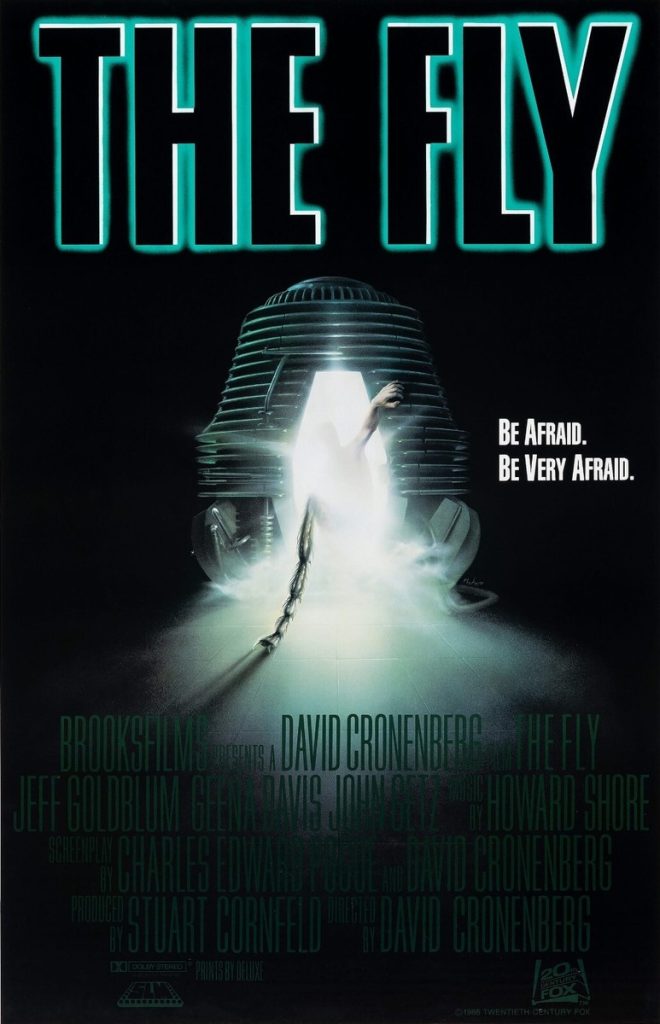
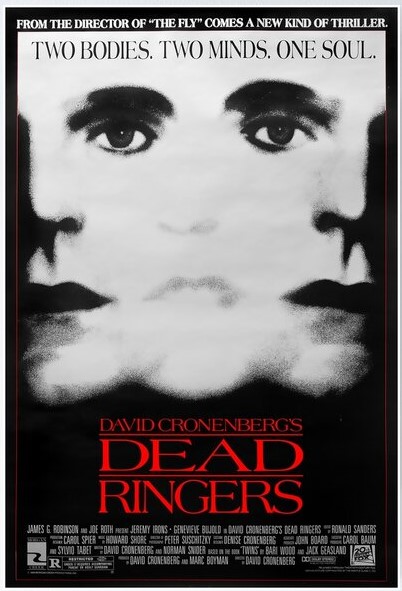

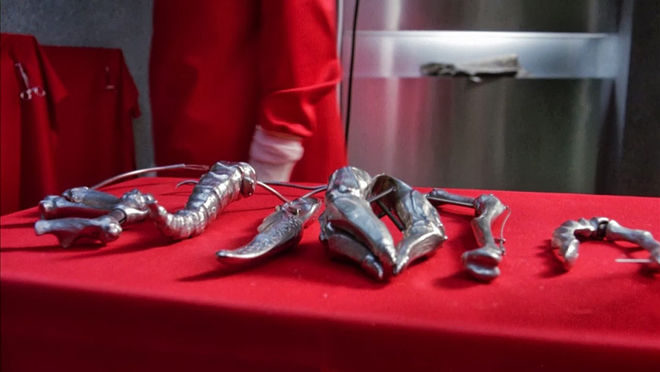
Recent comments